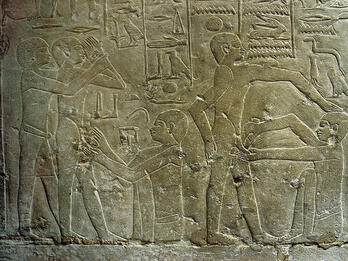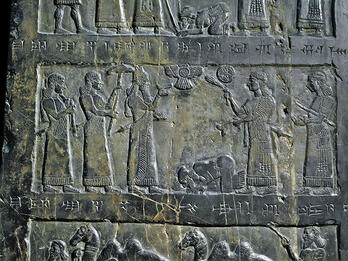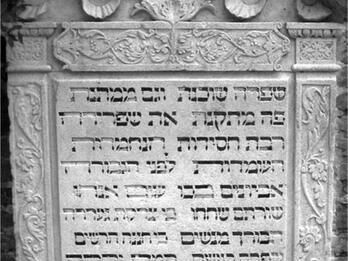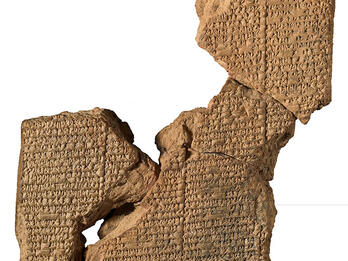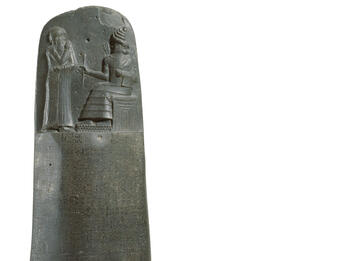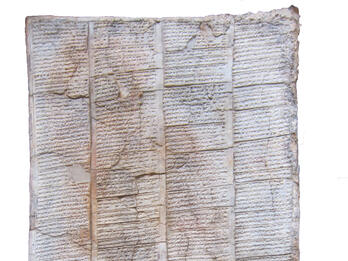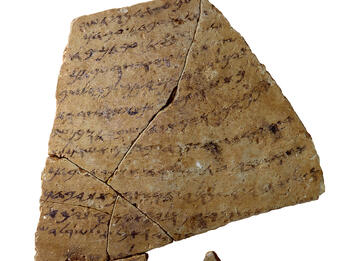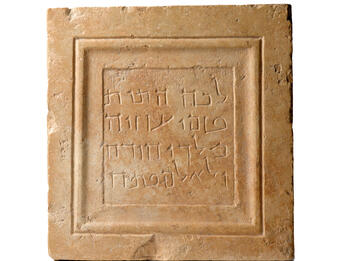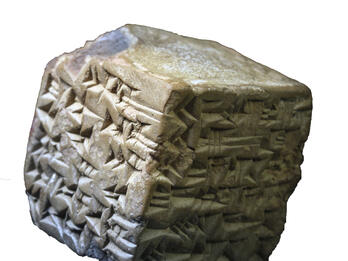Showing Results 1 - 10 of 18
Restricted
Image
Circumcision in an Egyptian relief, Sakkara, Egypt, Sixth Dynasty (ca. 2350–2170 BCE). Priests perform circumcision on boys. The hieroglyphic legend reads “circumcision.” The hands of the boy on the…
Places:
Sakkara, Egypt
Date:
Old Kingdom (Egypt), 23rd–22nd Century BCE
Subjects:
Categories:
Restricted
Image
The panel shown here is part of an obelisk that contains a long inscription summarizing the triumphs of the Assyrian king Shalmaneser III (r. 858–824 BCE) until the thirty-third year of his reign. The…
Places:
Calah, Assyria (Nimrud, Iraq)
Date:
859 BCE–824 BCE
Subjects:
Categories:
Restricted
Image
Tombstone of Shifra Tamari (d. 1565), Padua, Italy. In the early modern period, most Jewish tombstones in Italy were Italian Renaissance in style. Hebrew epitaph poems, like the one on this gravestone…
Places:
Padua, Venice (Padua, Italy)
Date:
1565
Subjects:
Categories:
Restricted
Image
The flood story in the Atrahasis Epic, Babylonia, 17th century BCE. The epic relates the early history of humanity from creation through the flood. Apart from its polytheistic perspective, it has many…
Places:
Sippar, Babylonia (Tell Abu Habbah, Iraq)
Date:
Middle Bronze Age
Subjects:
Categories:
Restricted
Image
Laws of Hammurabi on Babylonian Stela, eighteenth century BCE. The stela was originally placed in the temple of the god Marduk in the city of Babylon. Inset shows part of the prologue.
Places:
Babylon, Assyria (Babylon, Iraq)
Date:
Bronze Age, 18th Century BCE
Subjects:
Categories:
Restricted
Image
Vassal Treaty of Esarhaddon, King of Assyria (reigned 681–669 BCE). This copy of the treaty was found in the inner sanctum of the Assyrian temple in Tell Tayinat (in southeastern Turkey), where it was…
Places:
Kinalua, Assyria (Kıyıbucak, Turkey)
Date:
Iron Age IIC, 7th Century BCE
Subjects:
Categories:
Restricted
Image
Legal complaint on ostracon, Metsad Hashaviahu, Israel, from the late 7th century BCE. A worker states that a superior took his garment despite the laborer having fulfilled his work requirements…
Places:
Meṣad Hashavyahu, Land of Israel (Yavneh, Israel)
Date:
Late 7th Century BCE
Subjects:
Categories:
Restricted
Image
Uzziah’s reinterment inscription, Jerusalem. King Uzziah (reigned 785–733 BCE) was a leper and therefore, according to the book of Chronicles, could not be buried in the royal tombs and so had to be…
Places:
Jerusalem, Land of Israel (Jerusalem, Israel)
Date:
Roman Period, 1st Century BCE or CE
Subjects:
Categories:
Restricted
Image
Idol-quickening instructions, Babylonia, 6th century BCE. The “mouth-washing” ritual was a ceremony for transforming a newly manufactured idol into a living deity. The instructions include these…
Places:
Babylonia (Babylon, Iraq)
Date:
6th Century BCE
Subjects:
Categories:
Restricted
Image
Lot (puru), Assyria, 8th century BCE. The inscription identifies this as a lot (puru—the Akkadian form of Hebrew pur, the word used in Esther 3:7) that belonged to an Assyrian official named Yahalu…
Places:
Assur, Assyria (Qal'at Sherqat, Iraq)
Date:
Iron Age II, 9th Century BCE


